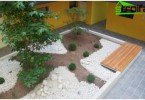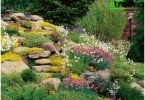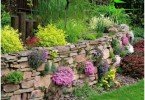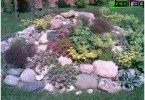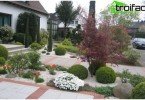Features of creating green lawns
Sowing the lawn with your own hands, you need to choose a mixture of herbs that will meet the requirements for it. Ordinary (another name for landscape gardening) green lawn is optimal for cottages and home gardens. Before planting herbs, it is necessary to carry out a series of preparatory work: to clean the site, remove excess bushes, trees, dig the ground. An important nuance that provides the beauty of the lawn is a dense compaction of the earth. The drainage device will be useful.
Content
- Features of the soil for the plot under the lawn and weed removal
- Drainage device
- Preparing land for grass planting and lawn care
- Suitable lawns for gardening and manual planting of seeds
Features of the soil for the plot under the lawn and weed removal
It’s not so difficult to sow the lawn in the country with your own hands, but there are some nuances here. Be sure to clean the site, uproot stumps, unnecessary trees, bushes. At this stage, it is worth laying paths, borders and other decorative elements. The soil for the lawn should be fertile with a slightly acidic or neutral pH.
Before planting seeds, you need to make a deep digging and remove weeds. Clods of earth are important to break. Weeds are weeded, mowed or treated with herbicides. If you decide to use a special tool.
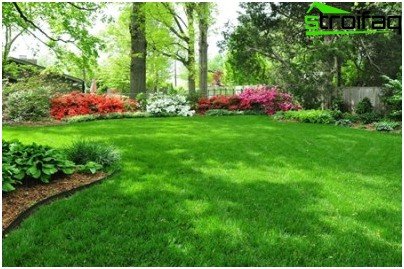
Paths and decorative elements are best planned before planting grass..
To prepare the mixture take 80 – 120 ml of the herbicide, which are diluted in a bucket of water. The consumption of the drug Roundup is 5 liters per 100 m2. To completely destroy weeds, it will take about 3 to 4 weeks. If the weather was wet and warm at that time, then unwanted germination of fresh seeds is possible. Then additional herbicide treatment is recommended..
It happens that in the area the soil is poorly suited to create a lawn. In this case, it is best to replace the topsoil. To do this, unsuitable soil for sowing is removed, drainage is arranged and it is covered with a fertile mixture of soil, peat and sand. For people who first make a lawn on the site with their own hands, the video can provide some help.
Drainage device
When deciding how to make a lawn with your own hands, you should worry about removing excess moisture from areas where water stagnates in the spring months after thawing snow and heavy rains. As a rule, drainage is always arranged when replacing the upper infertile soil layer. If such a procedure is not expected and the soil suits, then the earth is dug up, laid aside.
Then you can make the easiest option for drainage. To do this, lay out 10 – 20 cm of crushed stone, broken brick or gravel, then this layer is tamped and another 10 cm of sand is covered with top. After this, fertile land is returned to the place. The optimum soil height is 15 cm. It is very important to tamp each layer.
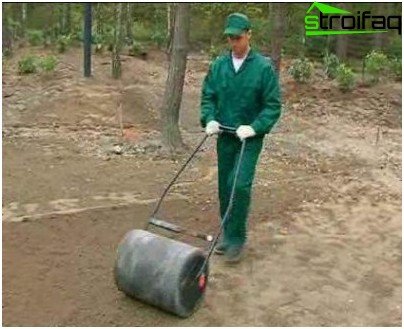
The easiest way to tamp the ground under the lawn with a hand roller
In order to make the earth more dense, special rollers are used with a length of 0.5 – 1 m and a weight of 20 – 50 kg. The cost of such a device pushes gardeners to use home-made devices, for example, water containers (barrels, cylinders) or metal pipes.
Sometimes for ramming the earth using boards or plywood sheets that go. The disadvantage of this method is that the pressure area is large and it is difficult to carry out this event qualitatively. In order to keep the lawn level it is important not to allow tubercles and dimples.
Preparing land for grass planting and lawn care
Do-it-yourself green lawn requires some care, which comes down to regular pruning, seeding, top dressing, aeration and weed removal. Most often, green meadows are sown in late summer, autumn or spring. For the winter, they dig a plot, carefully choose weeds, especially dandelions. Then you can make compost, humus, wood ash.
Light sandy soils improve peat and a small amount of clay, and clayey – coarse sand. In the spring, the site is again dug up and after 30 days you can start sowing herbs. After digging the earth, you can make complex mineral fertilizers. For 100m2 it is enough to use 2 – 3 kg of product.
Further dressing is carried out several times a year, sprinkling the mixture on dry herbs. Fertilizer consumption is about 50g / m2. Watering can be carried out immediately after making mineral mixtures, which will allow the granules to dissolve, and nutrients, in turn, can be absorbed faster.
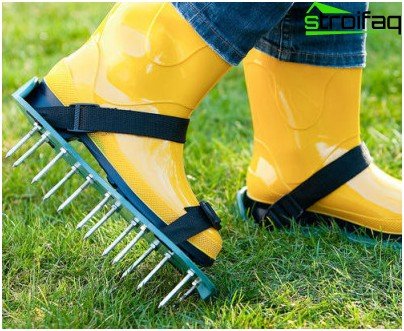
To improve root growth, you can use devices that pierce the soil every 5 to 8 cm
The root formation process and drainage properties can be improved by piercing the soil every 5 to 8 cm. In addition, the outflow of excess water during heavy rainfall will be much better on lawns located at an angle. Sometimes it’s even recommended to make a small slide in the center of a green meadow.
Suitable lawns for gardening and manual planting of seeds
There are several varieties of green lawns, but most often garden gardens or, as it is also called, an ordinary lawn are set up in personal gardens. This type is resistant to trampling, so it is easy to have a picnic on it or to run around with the kids. Other advantages of the ordinary type of green lawn are its relative unpretentiousness (in comparison with the ground or English) and ease of creation.
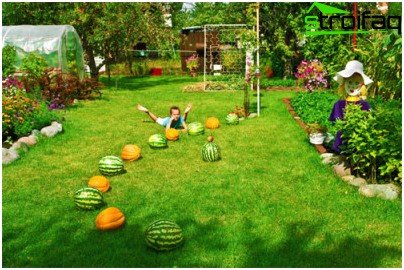
The usual lawn is resistant to trampling, therefore, more than others suitable for personal plots
Do-it-yourself lawn planting is most easily done using specialized seeders. If there are none, then you can use the rake by sowing the grass manually. Seed consumption is 10 – 15 g per 1 m2. Thicker sowing does not make sense. This can even be harmful, because in the soil there are not enough nutrients for all sprouts.
The ideal weather for sowing is a dry, calm day. First of all, the site is watered with water. Then seeds are sown, distributing them evenly over transverse strips 1 meter wide. After that, 2 cm of soil is poured on top and gently level the ground with a rake or a flat bar.
For sowing on an ordinary lawn, located in a shaded place, such grass mixtures are suitable:
- 20% meadow bluegrass, 30% white meadow, 50% meadow fescue;
- 30% meadow bluegrass, 30% pasture ryegrass, 40% red fescue.
For a sunny place, the following seed collection is suitable: 30% of the common comb, 70% of the shoot of the bentwood. If the green carpet is placed along the fence, then the optimal mixture of herbs for an ordinary lawn includes 30% red fescue and 70% meadow meadow grass.
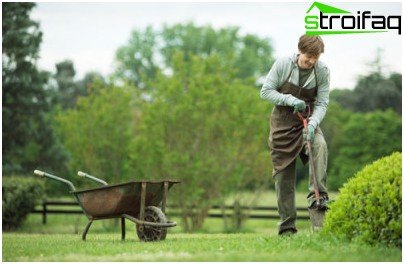
You can plant a lawn with your own hands, however, you must responsibly approach the preparation of the site and direct sowing so that the end result does not disappoint
Having an idea and knowledge of how to plant a lawn with your own hands, a gardener gets new opportunities for decorating a personal plot. There are important nuances in this business. If you think you can get a great lawn just by sowing grass, you are deeply mistaken. Green lawns need care, top dressing, aeration. It is also necessary to worry about removing excess moisture.


